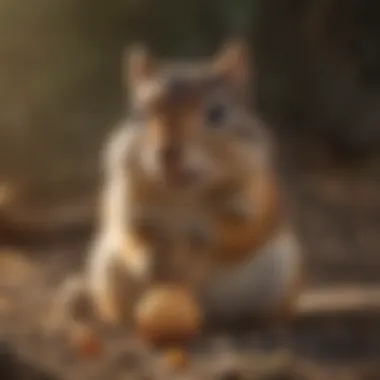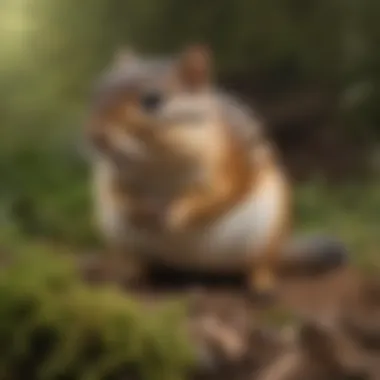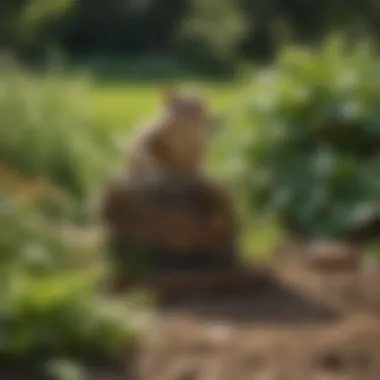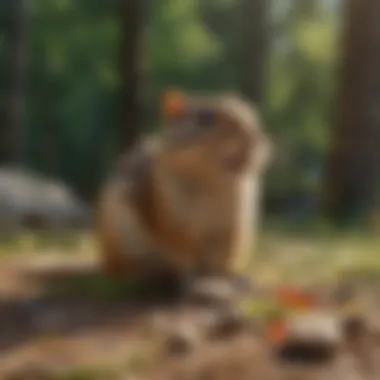Best Bait for Chipmunk Traps: A Complete Guide


Intro
Pest management is a pressing concern for many homeowners, particularly when dealing with chipmunks. These small rodents may appear harmless, but they can cause significant damage to gardens, and homes, and pose potential health risks. To address this issue effectively, understanding their feeding habits and behaviors is paramount.
By honing in on the most effective bait options, homeowners can ensure a more humane and efficient trapping process. The right bait not only attracts chipmunks but also increases the chances of successful traps. This article serves as a comprehensive guide for determining the best bait for chipmunk traps, offering an in-depth analysis of various bait types, their preparation methods, and regional considerations.
Understanding Pests
Definition of Pests
Pests are organisms that cause harm, annoyance, or detriment to humans and their environment. In this context, chipmunks fall under the category of pests when they invade gardens or homes. Their gnawing habits can damage electrical cords, insulation, and plants.
Importance of Pest Identification
Identifying specific pests is crucial for deploying effective control measures. Understanding the type of pest allows homeowners to tailor their approach. Chipmunks, for example, are known for their burrowing behaviors and come out mainly to forage for food. They are particularly drawn to seeds, nuts, and fruits. Familiarizing oneself with these characteristics can significantly improve the efficacy of trapping efforts.
Best Bait Options for Chipmunk Traps
Choosing the right bait is critical in successfully trapping chipmunks. Various natural and human-made options can be utilized. Below are some of the most effective choices:
- Sunflower Seeds: Highly appealing to chipmunks, sunflower seeds are often one of the top bait selections.
- Peanut Butter: This sticky bait is difficult for chipmunks to resist. It can be smeared on trap triggers to ensure they engage with the mechanism.
- Fruits: Fresh pieces of fruit such as apples or grapes can attract chipmunks due to their sugary scent. Dried fruits are also effective.
- Nuts: Acorns or walnuts are natural food sources and can serve as bait that lures chipmunks in.
When opting for human-made baits, consider commercial chipmunk baits that are designed to be more enticing.
Preparation and Placement
Proper preparation and placement of bait are vital for success.
- Preparation: Setting bait should involve keeping it fresh and ensuring it is securely placed within the trap. Condition of the bait can influence the willingness to approach it.
- Placement: Traps should be set near areas where chipmunks are frequently spotted, such as garden beds or along pathways. This increases the likelihood of a successful capture.
"Successful trapping hinges not just on bait, but also on strategic placement and observation of pest behavior."
Ending
In summary, this guide provides an insightful look into selecting the best bait for chipmunk traps. By understanding chipmunk behavior, various bait options, and preparation techniques, homeowners can enhance their approach to pest management. The convergence of awareness and strategy lays the foundation for effective and humane trapping.
Understanding Chipmunk Behavior
Understanding chipmunk behavior is essential for effective trapping strategies. Their instincts and habits can inform which baits are most appealing and how to place them. Proper knowledge of these behaviors allows homeowners to execute more targeted strategies, ultimately improving trapping success. Chipmunks are creatures of habit; they prefer known safe paths and food sources. By leveraging this information, you can anticipate their actions, leading to informed choices in bait selection and trap placement.
Feeding Habits
Chipmunks have varied feeding habits that are crucial to consider when selecting bait. They eat seeds, nuts, fruits, and insects. In fact, seeds are often the primary food source for these small mammals. Sunflower seeds are a favorite among chipmunks. Their small size makes them easy to carry, and their high-fat content is appealing.
In the spring and summer months, chipmunks tend to consume more fruits and vegetables. Items like apples, carrots, and even berries can draw them in. Since they cache food, providing something they can carry off may encourage trapping effectiveness. It is best to consider what food is available in your area to ensure you are using the most attractive options.
Foraging Patterns
The foraging patterns of chipmunks reveal a lot about their behavior. They typically search for food during the early morning and late afternoon. In these times, they actively scour the ground for available food, relying on their keen eyesight and acute hearing. Observing these patterns can dictate the timing of trap placement. Traps set during these hours are more likely to capture unsuspecting chipmunks as they search for food.
Moreover, chipmunks tend to follow the same paths repeatedly when foraging. They become comfortable using specific routes, which can be beneficial for trap location. By placing bait in areas where they frequently forage, you enhance your chances of success.


Seasonal Variability
Chipmunk behaviors vary significantly with the seasons. During the warmer months, they are highly active, foraging for food in order to store up for winter. This is when bait choice is most critical, as they focus heavily on seeds and nuts. However, as the temperature drops, their activity level may reduce. They tend to stay in their burrows more, coming out for quick nut searches.
In the fall, you might notice a shift towards higher quantities of acorns or similar hard seeds, as these are plentiful and easy to store. To adapt to this seasonal variability, adjust your bait selections accordingly to match their preferences during different times of the year.
By understanding chipmunk behavior, including their feeding habits, foraging patterns, and seasonal changes, homeowners can better devise trapping strategies that are humane and effective.
Importance of Bait in Trapping
Understanding the significance of bait in trapping is crucial for success. The choice of bait can mean the difference between an effective trap and wasted effort. Chipmunks are attracted to food sources, and bait plays a pivotal role in drawing them in. A well-selected bait not only ensures higher capture rates but also influences the overall effectiveness of the trapping strategy.
Selecting the right bait requires insight into the behavioral patterns of chipmunks. Their natural preferences and dietary habits guide homeowners in making informed decisions. The right bait appeals to their instincts and can significantly increase the chances of successful trapping.
Psychological Attraction
Chipmunks are driven by their need for food. They are opportunistic feeders that react to the scent and availability of enticing food sources. Psychological attraction refers to how bait influences the chipmunk's behavior by tapping into its hunger cues. When the bait is aligned with their natural diets, chipmunks are more likely to approach.
For instance, sunflower seeds possess a strong scent that can lure chipmunks toward traps. The aroma signals food, triggering exploration behavior. Other food items, such as peanut butter, have a sticky texture that makes them appealing and can hold the chipmunk's attention longer. If the bait is not appealing, the chances of success diminish. When chipmunks find the bait particularly irresistible, they may not even notice the trap mechanism.
Minimizing Trap Aversion
Trap aversion occurs when a chipmunk becomes aware of a trap and becomes wary or refuse to approach it. This is a common risk in trapping, as the presence of unfamiliar objects can alert intelligent creatures like chipmunks. To combat this, bait serves as a distraction, drawing attention away from the trap itself.
Using highly appealing baits allows the trap to become a secondary concern for the chipmunk. Reducing aversion is about ensuring that the bait is stronger than the instinct to avoid potential danger. Selecting baits that chipmunks naturally encounter in their environment also suggests safety. For example, if a trap is baited with apples or bananas, which chipmunks might find in a garden, it feels less threatening. This familiarity creates an impression of safety, encouraging the chipmunk to investigate further without suspicion.
In summary, understanding the role of bait can greatly enhance trapping efforts. Psychological attraction influences a chipmunk’s initial willingness to engage, while minimizing trap aversion increases the likelihood of capture. The careful selection and presentation of bait can lead to more successful and humane trapping outcomes.
Top Bait Options
Choosing the right bait is crucial for effectively trapping chipmunks. Not only does it influence the chances of a successful catch, but it also reflects an understanding of chipmunk preferences. Bait selection impacts several factors such as trap efficiency and the overall humane aspect of trapping. Therefore, knowing which baits are most enticing to chipmunks can lead to better trapping results.
Seeds and Nuts
Seeds and nuts are often the top choices when it comes to baiting traps for chipmunks. These food items tap into the natural instincts of chipmunks, appealing to their foraging behaviors. The high-fat content in seeds and nuts makes them attractive as they provide essential energy reserves for these small mammals.
Sunflower Seeds
Sunflower seeds are particularly effective due to their oil content, which chipmunks find appealing. The small size of the seeds makes them easy for chipmunks to handle and consume. Their popularity as bait stems from chipmunks’ natural foraging habits, where they seek seeds in their environment. However, while sunflower seeds are attractive, they can also be easily scattered outside the trap, reducing their effectiveness.
Peanut Butter
Peanut butter is a favored choice among many animal trappers. Its strong scent can lure chipmunks from a distance, making it an optimal bait. The sticky texture encourages chipmunks to remain in the trap longer, increasing the chances of a capture. One drawback is its messiness, which can create scent trails and draw attention from other animals, possibly affecting trap effectiveness.
Walnuts
Walnuts also serve as a good option for bait. They are rich in fats and protein, beneficial for chipmunks. Their hard shells may require chipmunks to spend more time trying to get to the meat, which can be advantageous in ensuring they stay near the trap. However, the shell can pose a challenge to less experienced chipmunks, keeping them from the bait entirely.
Fruits and Vegetables
Fruits and vegetables also catch the interest of chipmunks. These options provide variety and appeal to their diverse diet. The moisture content in fruits particularly draws attention, allowing traps to be more attractive to chipmunks seeking hydration.
Apples


Apples are a solid choice due to their sweet scent. They can entice chipmunks who are naturally drawn to sugary foods. Additionally, sliced apples can be placed directly in traps, making it easier for chipmunks to access them. However, apples can spoil quickly in warmer weather, so timely replacement may be necessary.
Carrots
Carrots offer a crunch that chipmunks enjoy. They are nutritious and easy for chipmunks to gnaw on. Their long-lasting nature makes them a practical option, but their appeal may not match that of sweeter options like apples. It is best to use fresh carrots to ensure maximum attractiveness.
Bananas
Bananas can be highly effective due to their strong aroma. Chipmunks are often drawn to ripe bananas, which can be easily smashed or sliced. This accessibility may lead to higher success rates in trapping. The downside here is that bananas spoil quickly, requiring regular monitoring for freshness.
Commercial Bait Alternatives
For those who may not want to use standard food items, commercial bait alternatives are also available. These options are designed specifically for attracting rodents and can simplify the trapping process.
Specialized Rodent Baits
Specialized rodent baits are formulated to appeal specifically to rodent preferences. They often contain a blend of scents and tastes that mimic natural food sources. Their key characteristic is effectiveness; however, the cost can be higher than natural alternatives. Some users find these baits work more quickly than traditional options.
Homemade Mixtures
Homemade mixtures can be tailored to specific environments and needs. Combining various food items can create a unique bait that is particularly enticing based on the region. A mixture of seeds, nuts, and fruits can yield an effective bait. One disadvantage is that they may require preparation time, which some may find inconvenient.
Preparation and Presentation of Bait
The effectiveness of chipmunk trapping relies significantly on how the bait is prepared and presented in the traps. This section covers crucial elements such as optimal quantity, bait placement techniques, and bait preservation. Each component plays a role in ensuring that the traps operate effectively, attracting chipmunks while minimizing potential waste of resources.
Optimal Quantity
Finding the right amount of bait to use is essential for successful trapping. Using too little may not attract chipmunks, while too much can deter them due to suspicion. A general guideline is to start with a small amount that is just enough to entice the animal. For seeds or nuts, a few pieces placed strategically in the trap can be sufficient. Some experts suggest a quarter of a cup, depending on bait type.
Additionally, reducing the bait quantity after initial attempts can help gauge trap activity. Adjustments can be made based on the frequency of visits. Tracking how often the bait is consumed can indicate whether the quantity is appropriate.
Bait Placement Techniques
Proper placement of bait in the trap is another crucial aspect. Bait should be located in a way that encourages chipmunks to enter the trap fully. Here are some recommended techniques:
- Centering the Bait: Place bait in the center of the trap to ensure that chipmunks must enter fully to access it.
- Using Bait Holders: Employ bait holders to secure the bait, preventing chipmunks from removing it without triggering the trap.
- Creating a Scent Trail: Consider creating a scent trail leading into the trap, using crushed nuts or fruits to guide them in.
Experimenting with different placements can yield varying results, so be mindful of the local chipmunk behaviors and trends.
Bait Preservation
Keep in mind that bait quality is paramount. Bait should be fresh and appealing. Fruits and vegetables spoil quickly, while nuts can lose their aroma over time. Store unused bait in a cool, dry place, ensuring it remains viable for future use. For perishable bait, monitor freshness before each use, and replace any bait that appears moldy or unattractive.
Fresh bait is more likely to draw in chipmunks, leading to effective trapping outcomes.
In summary, the preparation and presentation of bait involve thoughtful considerations of quantity, placement, and preservation. These elements combine to create a trapping environment that not only attracts chipmunks but also encourages them to engage with the trap effectively.
Evaluating Bait Effectiveness
When it comes to trapping chipmunks, the effectiveness of the bait is a crucial component. Evaluating how well your bait works can save time, effort, and resources. Understanding the interaction between chipmunks and bait can improve trapping strategies. Moreover, consistent evaluation allows homeowners and pest managers to adapt to changing conditions. This section outlines essential aspects of bait effectiveness and the associated benefits.


Monitoring Trap Success
Monitoring the success of traps is vital for assessing the performance of the bait used. This involves checking traps regularly to determine if chipmunks are being caught. Not only does this provide insights into bait acceptance, but it also helps in adjusting strategies if success rates are low.
- Frequency of Checks: It's recommended to check traps at least once a day. This minimizes the risk of distress to trapped animals and allows for timely evaluation of bait effectiveness.
- Recording Results: Keeping a log of what bait was used, the number of chipmunks caught, and the time of day can help identify patterns. This data can lead to better decisions about whether to continue with the same bait or try alternatives.
- Consider Environmental Factors: Weather, regional wildlife activity, and seasonal changes can influence trap success. Note any correlation between environmental shifts and trapping outcomes to adjust bait accordingly.
By being diligent in monitoring, you can enhance the overall success rate of your trapping efforts.
Adjusting Bait Strategies
Once you start monitoring your traps and assessing the effectiveness of your bait, it may become necessary to adjust your bait strategies. Flexibility can lead to better results over time. Here are key approaches to adapting your bait strategies:
- Evaluate Bait Preference: Chipmunks have diverse preferences; observe which bait types lead to higher trapping rates. If one option does not seem effective, consider switching to another type, whether it’s nuts, seeds, or fruits.
- Combine Bait Types: Sometimes, combining a few different bait types can yield better results. This can create a more appealing scent or taste for the chipmunks.
- Change Placement: Experiment with bait placement. Moving the bait closer to the trap entrance or adjusting its position can entice more chipmunks to investigate.
- Seasonal Adjustments: Be aware of seasonal changes in chipmunk behaviors and food sources. What works in the spring might not be as successful in the fall. For example, incorporating fruits in warmer months may serve better than seeds.
Adapting bait strategies based on observations is central to improving trapping efficiency.
"Evaluating the effectiveness of your bait and making adjustments allows for continuous improvement in trapping success."
These practices ensure that homeowners and pest managers can employ methods that resonate with the behaviors and preferences of chipmunks, ultimately leading to more effective control measures.
Environmental Considerations
When trapping chipmunks, it is vital to consider environmental factors that can influence the success of bait strategies. Chipmunks have specific behaviors and habitats that vary by regions. Understanding these aspects can help maximize the effectiveness of the chosen bait while being mindful of local ecosystems.
Regional Food Availability
The geographical area significantly affects what chipmunks are likely to eat. Various nuts, seeds, and fruits are seasonal and vary by location. For example, areas with abundant oak trees might have a higher availability of acorns, which chipmunks favor. If these are readily available in the area, they may not respond as well to bait that does not align with their natural food sources.
It is essential to research local food sources in your region before deciding on bait. A simple approach is to observe what chipmunks are taking from gardens or bird feeders. This can provide insights into their preferences. By aligning bait options with the natural diet of chipmunks in the locality, the likelihood of trapping success increases.
Impact on Non-target Species
Using bait that is particularly attractive to chipmunks may also draw in non-target species, including birds, rabbits, or even household pets. This situation presents ethical dilemmas and can complicate the trapping process. For example, a trap designed for chipmunks may inadvertently catch other small animals, leading to potential harm or injury.
One way to mitigate this impact is to use bait that specifically appeals to chipmunks while being less attractive to other species. For instance, using sunflower seeds can be effective, however, it might also draw in other birds. Understanding the local wildlife can help in selecting bait that minimizes this risk. Additionally, positioning traps in areas less frequented by non-target species may further enhance effectiveness.
Remember, a responsible approach to trapping involves not only targeting the desired species but also safeguarding the welfare of neighboring wildlife.
In summary, taking environmental considerations into account is not merely about attracting chipmunks. It requires a comprehensive understanding of local dynamics that affect food availability and non-target species interactions. This awareness will enhance the success of your trapping efforts and promote a responsible, ethical approach to wildlife management.
Legal and Ethical Aspects of Trapping
Addressing the legal and ethical aspects of trapping chipmunks is vital for both pest control and the protection of wildlife. Understanding these factors ensures responsible practices when dealing with chipmunk populations. The significant issues include humane trapping methods and compliance with local regulations. This knowledge not only fosters a more ethical approach but also minimizes potential legal repercussions.
Humane Trapping Guidelines
Humane trapping guidelines prioritize the well-being of chipmunks while allowing for effective removal. Here are key considerations to keep in mind:
- Choose humane traps: Select traps that prevent any harm to the animal, such as live-capture traps. These devices capture chipmunks without injury, enabling safe relocation.
- Regular monitoring: Check traps frequently, ideally every few hours. This minimizes stress and suffering for the captured chipmunks.
- Proper handling: When relocating, ensure chipmunks are released in suitable environments far from populated areas to prevent re-entry and stress on native fauna.
- Avoid overcrowding: Setting multiple traps in a small area can lead to overcrowding. Ensure that traps are spaced adequately to prevent competition for resources each trap may offer.
By adhering to these guidelines, homeowners can manage chipmunk populations while respecting their rights as living creatures.
Local Regulations
Every region has its own regulations concerning trapping and removal of wildlife. Familiarizing oneself with these laws is crucial to ensure compliance. Important points include:
- Permitting requirements: Some areas may require permits for trapping chipmunks. Check with your local wildlife agency or department for information.
- Timing restrictions: Certain seasons may have restrictions on trapping due to breeding cycles. Timing your trapping efforts accordingly is essential to avoid penalties.
- Relocation policies: Laws may dictate where it is permissible to relocate captured chipmunks. Research the appropriate guidelines to avoid placing them in areas where they can cause problems.
- Species protection: Some regions designate chipmunks as protected species. Understand the implications of this designation and act accordingly.
By respecting both humane trapping guidelines and local regulations, homeowners can effectively manage chipmunk issues while exhibiting concern for animal rights and local biodiversity. Following these principles creates a balance between safeguarding property and promoting ethical wildlife management.



